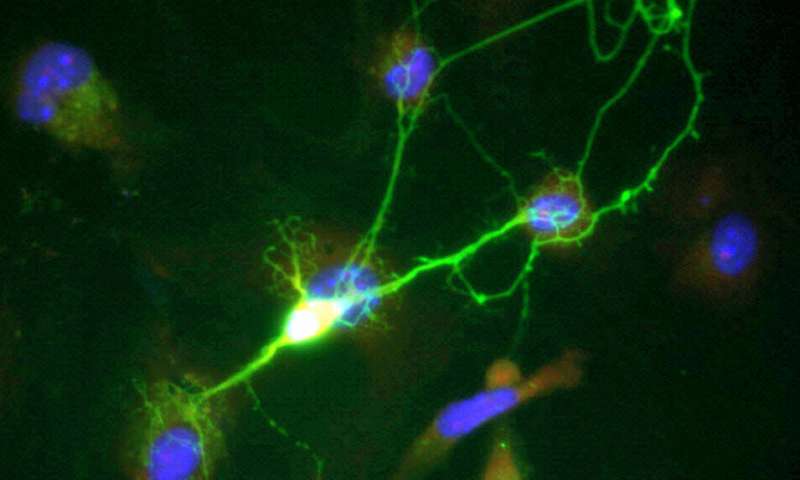When light is the switch: Nano-metric photodiodes to study the activity of neurons
In a novel approach, a new study at SISSA uses technology that can activate individual nerve cells with a light impulse. This targeted, non-invasive approach can be used for fundamental studies into the nervous system as well as the development of innovative therapies for neurological diseases
在一种新的方法中,SISSA的一项新研究使用了一种可以用光脉冲激活单个神经细胞的技术。这种有针对性的非侵入性方法可用于神经系统的基础研究以及神经疾病创新疗法的开发
A jolt of light to modulate the activity of a single neuron in real time: This is how innovative nanometric photodiodes work, the subject of a new research study published in Science Advances. The technique was developed by Professor Laura Ballerini’s team at SISSA in Trieste, in collaboration with the Universities of Chicago and Cambridge.
一束光实时调节单个神经元的活动:这就是创新的纳米光电二极管的工作原理,这是发表在《科学进步》上的一项新研究的主题。这项技术是由位于的里雅斯特的SISSA的劳拉·巴莱里尼教授团队与芝加哥大学和剑桥大学合作开发的。
When activated with an infrared ray, photodiodes of nano-metric scale send an electrical message to the nerve cell to which they are bound, regulating its function. The effect of the stimulation can then be extended and amplified to the surrounding network of neurons in virtue of their synaptic contacts. Working like a real electrode, but with a noninvasive and selective approach, these nanotechnologies could be extremely useful for basic research, to investigate in-depth the mechanisms of the nervous system, but also to develop targeted therapies for neurological diseases.
当被红外线激活时,纳米级的光电二极管向它们所连接的神经细胞发送一个电信号,调节其功能。然后,刺激的效果可以通过突触接触扩展并放大到周围的神经元网络。这些纳米技术可以像真正的电极一样工作,但采用非侵入性和选择性的方法,在基础研究、深入研究神经系统的机制以及开发神经疾病的靶向疗法方面非常有用。
Nanometric photodiodes: Here is how they work
纳米光电二极管:以下是它们的工作原理
“To investigate the functioning of the nervous system, there is now great interest in technologies that must be both very precise and non-aggressive. Our strategy goes precisely in this direction. Differently from what explored so far, where metal electrodes or the optogenetic combination of genetic manipulation and optical techniques were used, we pursued a new, more specific and less invasive approach,” say Professor Ballerini and her collaborators, Denis Scaini and Mario Fontanini.
“为了研究神经系统的功能,现在人们对必须非常精确和非攻击性的技术非常感兴趣。我们的战略正是朝着这一方向发展。与迄今为止探索的不同,我们采用了金属电极或遗传操作和光学技术的光遗传学组合,我们追求了一种新的、更具体和更具侵入性的技术。”Ballerini教授和她的合作者Denis Scaini和Mario Fontanini说。
In the study, the SISSA research group used innovative nano-metric photodiodes, developed by the University of Chicago, which are capable of binding to the surface membrane of nerve cells. “The photodiodes light up when illuminated with infrared light,” explain the scientists. “In this way they can act electrically on the nerve cell, activating it. This is extremely useful for research purposes because it allows us to see what role a specific neuron plays in a given process and, since infrared is able to penetrate tissue, modulate its activity from the outside in an agile and non-aggressive way.”
在这项研究中,SISSA研究小组使用了创新的纳米光电二极管,由芝加哥大学开发,能够与神经细胞的表面膜结合。科学家解释说:“当用红外光照射时,光电二极管会发光。”“通过这种方式,它们可以对神经细胞产生电作用,激活神经细胞。这对于研究目的非常有用,因为它可以让我们看到特定神经元在给定过程中发挥的作用,并且,由于红外线能够穿透组织,因此能够以敏捷和非攻击性的方式从外部调节其活动。”
But how do you get the photodiode to the neuron you wish to study? Thanks to an ingenious mechanism developed in collaboration with Ljiljana Fruk’s group from University of Cambridge: “The photodiode is bound to an antibody that works like a courier taking and hooking it exactly where we wish to. This is because the antibody recognizes with great specificity a structure that we know is on the surface of the target neuron.”
但是如何将光电二极管连接到你想要研究的神经元上呢?由于与剑桥大学的Ljiljana Fruk团队合作开发了一种巧妙的机制:“光电二极管与一种抗体结合,就像一个信使,将其准确地带到我们想要的地方,并将其挂钩。这是因为该抗体能够非常特异性地识别我们知道的目标神经元表面的结构。”
New technology with a huge potential
具有巨大潜力的新技术
Working in the laboratory on explant sections of the spinal cord, the SISSA staff focused on the study of the sensory neurons involved in pain pathways: “We realized that our method is able to selectively stimulate individual cells, allowing us to activate individual neurons with opposite functional roles, e.g., excitatory or inhibitory,” explain the researchers. “By activating an excitatory neuron on the spinal dorsal horn with the photodiode, we witnessed an amplification of the pain signal. Vice-versa, by acting on an inhibitory neuron the opposite effect was obtained: the amplification of the pain signal was switched off.”
SISSA工作人员在实验室对脊髓的外植体切片进行了研究,重点研究了参与疼痛通路的感觉神经元:“我们意识到,我们的方法能够选择性地刺激单个细胞,使我们能够激活具有相反功能作用的单个神经元,例如兴奋性或抑制性,”研究人员解释说。“通过用光电二极管激活脊髓背角上的兴奋神经元,我们看到了疼痛信号的放大。反之,通过作用于抑制神经元,获得了相反的效果:疼痛信号放大被关闭。”
Read more at Phys.org
在Phys.org阅读更多











